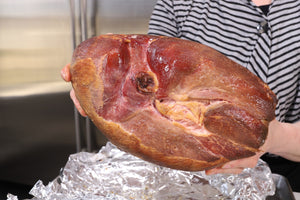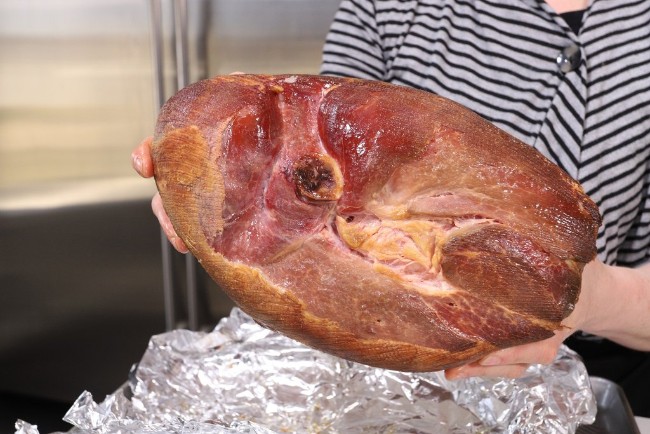How to Cure a Ham - Smoked Ham Recipe
Go ham and make your own Cured & Smoked Ham.
Sure, you could go to the store and pick up a conveniently packaged spiral glazed ham. Or you could obtain ultimate bragging rights by curing and smoking your own ham at home. It's a project for sure, and smoking ham is not to underestimate, but it's worth the time and effort, plus you'll be able to control the salt and flavor levels. For the real cherry on top, finish your smoked ham recipe it off with a zesty Citrus, Pineapple, & Tequila glaze.
So how to cure ham? Let's get started:
What You'll Need For This Smoked Ham Recipe
- 8-10 lb. Bone-in Fresh Ham, skinless
- 2 packages PS Complete Ham Cure: This award-winning cure makes a delicious brine that will rival any store-bought ham.
- 5 lbs. Water
- Large Mixing Bowl
- Glass Measuring Cup
- Meat Injector
- Large Pot with Lid (We used a large Dutch oven)
- Stockinette
- Smoker or Grill: For this recipe, we used the Pro Smoker PK 100 which uses sawdust for a thick, but even smoke flavor.
- Time: Plan on 2-4 days for curing*, 1 day for resting, 1 day for smoking, and a final day for baking, for a total of 7 days.
- Citrus, Pineapple & Tequila Glaze
*Curing ham for 4 days will result in a saltier end product. If you are looking for a lower-sodium ham, brine for 2-3 days.
Ham 101
A ham comes from the back thigh/rump of a pig and can be purchased in a whole (18-20 lbs.) or half ham. The ready-to-eat ham you get at the store is generally a wet or brine-cured ham that is then smoked until pink and sliceable. A fresh or green ham (what you'll want to use for this recipe), is a ham that hasn't been cured and smoked. It's likely you won't be able to find this at your local grocery store, so be sure to check with your local meat market or butcher before getting started on this fresh ham recipe.
Selecting Your Ham
How to Cure Ham
Let's get started on curing ham. In a large bowl or pot, whisk together PS Complete Ham Cure and water to create a brine.

Remove 13 ounces of brine and inject it into the ham, being sure to inject around the bone. It is important to inject the amount of brine equal to 10 to 15% of the ham’s weight, into the flesh of the ham for the best cured ham results.

Place ham in a large pot with lid and pour the remaining brine around the ham. The ham should be completely submerged in the brine. Cover with plastic wrap, and press down on the ham, then cover with a lid. Refrigerate the ham in the brine for 2-4 days for the best ham curing results (we recommend one day for every 2 lbs. ).

After 4 days, remove the ham from the brine, and soak in cold water for 2 hours, changing out cold water after 1 hour. (Note: Another way to lower the sodium content of the ham is to refresh the water more frequently. For a less salty ham, change the water ever 30 minutes for 2 hours). Remove the ham from the water, place it in a glass baking dish, cover it with plastic wrap, and refrigerate overnight.


Ham Smoking Process
We're now halfway to getting our delicious smoked ham. We only need to get started with the ham smoking process.
Remove the cured ham from the refrigerator, uncover, and blot dry with paper towels.
Preheat the smoker to 130° F.
Place the cured ham in a stockinette and hang it from 2 hooks latched onto 2 stacked top grates. Add ⅔ pan of moistened sawdust and smoke the ham for 3 hours, with dampers ⅓ open.


After 3 hours, remove the pan of charred sawdust, then add another pan of moistened sawdust on the burner. Increase the temperature to 160° F and smoke the ham for another 3 hours.
After 3 hours, remove the sawdust pan and close dampers. Increase the temperature to 185° F, and keep smoking the ham until the internal temperature of the ham reaches 150° F.
Remove the smoked ham from the smokehouse, then refrigerate overnight, or freeze for future use. Note: A fresh, bone-in ham will take approximately 1 hour 20 minutes per pound to smoke at temperatures listed above.

Ham Baking & Glazing
Remove the smoked ham from the refrigerator 1 hour prior to roasting. Remove stockinette, then score the ham’s fat cap, creating a cross-hatch/diamond-cut look.
If you're one of those types who like their hams plain, then you can slice and eat as is after letting your smoked ham rest in the refrigerator overnight. You can also dice it up and toss it in your favorite soups, egg dishes, and more.
If you want to take it to the next level, we recommend baking and glazing your ham with a sweet glaze, like this Citrus, Pineapple & Tequila Glaze version with pineapple juice, brown sugar, orange marmalade, a hint of tequila, and fresh lime juice.





2 comments
Very interesting piece of work! I am a local butcher who occasionally process and produce ham in b PortHarcourt, Nigeria . Many thanks.
In Ham 101 you didn’t mention that commercial hams are also tumbled before smoking to make them tender. This is because they are minimally smoked- maybe an hour or so- and then finished in a steam cabinet to shorten the whole process to a few hours and maintain the water content of the meat. After all, it is sold by the pound.
The process you describe tenderizes the ham with a “long and slow” cook/smoke cycle that causes a 15% to 20% water/weight loss in the finished product but also produces a superior quality ham.
I have a Cabela’s branded PK50 (discontinued) and it is a beautiful and well made piece of equipment.